
If you’re looking for a long-form graphic novel with a linear narrative, this is not the book for you. Instead, Finnish cartoonist Tommi Musturi presents a compendium of his self-published 10-issue anthology series of the same name. He’s the sole contributor, and yet he switches his art style, including his lettering, so completely from one entry to the next that the book appears to be a true anthology by multiple creators.
Buy Future by Tommi MusturiThe shorts range from newspaper-style gag strips to intricately rendered ponderings on the nature of life, with recurring segments that allow readers to follow multiple loose stories throughout the book. The writing is more obtuse than revelatory, offering moods about the perils of late-stage capitalism and urban isolation without any real incisiveness or resolution. Text-heavy missives open and close each issue: a full-page stream of consciousness musing from a “Warehouse Keeper” at the start and a pseudo letters column (with both real and fake letters) to close. Dissertations could be written about what it all means, but at a surface level, the characters are all adrift and unsatisfied with life in the modern world.
One recurring segment is quite literally adrift, with a spaceship seemingly constructed out of a plastic shopping bag exploring the far reaches of the universe as its occupants attempt to find their purpose. In another, an alcoholic magician struggles to remain relevant in the face of changing societal tastes. One of the comic strips focuses on militant young kids grousing about the state of the world left to them by their ancestors, while another focuses on barely-veiled Flintstones knockoffs banging their heads as they attempt to eke out a living. It’s gloomy, but glimmers of humor shine through at times, and hope surfaces in the form of a luminous promised land named Centra where living is easy and in harmony with nature, rendered in light brushstrokes and warmly inviting watercolors.
The book succeeds as a vibrant showcase for Musturi’s chameleon-like ability to completely switch styles from segment to segment, concurrently making it impossible to pin down his identifying artistic markers, aside from the vivid and wildly unconventional coloring choices he makes in his full-color segments and individual issue covers. He’s operating on a whole other level from fellow creators here, offering a glimpse into truly original artistic approach that is both exciting and visceral. Even if you might not quite grasp what’s happening in the stories, the artwork is so jaw-dropping that the search for meaning can be wholly abandoned in favor of simply absorbing the massive artistic achievement represented throughout the book. The Future is here, and it is glorious.